Black Sabbath | ||
| Allmusic Biography : An English hard rock institution whose influence on heavy metal cannot be overstated, Black Sabbath not only pioneered the genre, they helped launch the career of one of its most colorful and controversial characters in Ozzy Osbourne. The band distilled the smoke and strife of its industrial hometown into a punitive blast of doom-laden heavy blues-rock via bass player Geezer Butlers dystopian lyrics, which leaned heavily on the occult, and guitarist Tony Iommis seismic riffing. When paired with Bill Wards economical yet formidable work behind the kit and Osbournes primal tenor, the effect was both powerful and accessible -- a blueprint for aspiring decibel pushers of every skill level. The band formed in 1968 under the ill-fitting name the Polka Tulk Blues Band -- Iommi and Ward, who had just left the pub blues outfit Mythology, were looking to take the genre in a more robust direction. They enlisted the services of Butler and Osbourne, both of whom had played together in a group called Rare Breed, and by the end of the year were operating under the moniker Earth. The transition from Earth to Black Sabbath took place the following year, after Osbourne and Butler penned a song that was inspired by the 1963 Boris Karloff horror film of the same name. The resulting "Black Sabbath," a funereal slab of blast furnace-forged dread built around the augmented fourth/tritonic interval, better known as the devils interval, would serve as the opening volley on their explosive eponymous 1970 debut. Released via Vertigo Records, the more progressive subsidiary of Philips/Phonogram, the bulk of the Rodger Bain-produced LP was recorded in a single day. Only a handful of guitar overdubs -- Iommis signature sound was lent considerable gravitas by the fact that he tuned his guitar a half-step down to provide some slack for a pair of fingers that saw their tips removed in a factory accident -- along with the rain, thunder, and tolling bells that so effectively introduced the group to the world, would be added later. The record was released on Friday the 13th, which helped kick-start the bands reputation for populating the fertile crime scene that is history with plenty of blood spatter. Flush with eventual genre classics like "The Wizard," "N.I.B.," and the aforementioned title cut, Black Sabbath was initially dismissed by critics -- retrospective reviews were far more reverent -- but it managed to reach the U.K. Top Ten and hold court for over a year on the U.S. Top 40, eventually going certified platinum. With the surprise success of Black Sabbath, the band wasted little time in getting back into the studio. Released just seven months after their debut, Paranoid, the very antithesis of the sophomore slump, would spawn two of their biggest singles in "Iron Man" and the nervy, hard-hitting title track, the latter of which would be the bands only Top Ten hit -- the LP went straight to the top of the U.K. charts, and sold over four million copies in the U.S. Deeper yet no less immediate cuts like the air-raid siren-led, politically charged "War Pigs" and the trippy, mellow doom anthem "Planet Caravan" showed a group that had far more creative gas in the tank than its detractors would have cared to admit. Paranoid also afforded Sabbath their first measure of controversy after an inquest was made regarding an American nurse who committed suicide while listening to the LP -- for many, the name Black Sabbath would become synonymous with Satanism throughout the 70s and 80s. Sabbath continued to blow the unholy horn of plenty with albums three and four. Released in 1971, the brutish Master of Reality was certified double platinum on the strength of fan favorites like "Sweet Leaf," "Children of the Grave," and "Into the Void," the latter two of which saw Iommi downtune three semitones in order to release even more string tension -- Butler followed suit, and the deep earth pummeling that followed has been widely cited as the auger of sludge, doom, and stoner metal. The LP also featured the Iommi-composed/Butler-penned "After Forever," which, much to the confusion of some of the bands more zealous critics, reflected the bass players deep Catholic faith. Vol. 4, recorded in Los Angeles, arrived the following year, and was the first Sabbath outing to not see Rodger Bain handling production duties -- Iommi and then-manager Patrick Meehan would co-produce the album. Certainly the groups most ambitious outing to date, Vol. 4 also represented Black Sabbath at their most chemically dependent -- the albums working title was Snowblind -- shipping in speaker boxes filled with cocaine, and turning their rented Bel Air house into a boozy black cauldron of rock star excess. Nevertheless, they managed to pull it together long enough to piece together a dark, introspective gem of a record that didnt spawn any hits -- the caustic riff-gasm that is "Supernaut" must have charted in some other more forgiving dimension -- but still topped the album charts. Vol. 4 dutifully reflected Sabbaths debauched collective headspace at the time, but retained enough of the blue-collar might that fueled their early works to connect. Arriving in 1973, Sabbath Bloody Sabbath was another success, doubling down on the more progressive elements of Vol. 4, even going so far as to tap Rick Wakeman from Yes to contribute keyboards to the track "Sabbra Cadabra." Bolstered by the now iconic title cut as well as the punishing "Killing Yourself to Live," the LP not only resonated with fans, but elicited positive comments from mainstream critics as well, becoming Sabbaths fifth platinum album in the U.S. and earning their first silver certification in the U.K. Sabotage, released in 1975, saw Sabbath returning to the bottom-heavy, molten metal attack of their debut, for the most part dialing back on the orchestral flourishes and studio trickery of their last two outings. It also arrived in the midst of contentious litigation between the band and its now former manager Meehan. Between the bruising "Hole in the Sky," the angst-fueled "Symptom of the Universe," and the nearly nine-minute epic "The Writ," the band sounded both reinvigorated and wrecked -- a bloodied beast, filled with bullets, standing on the corpse of its captor. Fans and critics were kind, but the musical climate was changing both at home and abroad, and Black Sabbath were beginning to feel the chill. By 1976 the band was undergoing an internal struggle as well, having to contend with an increasingly frustrated and chemically dependant frontman, who was looking to strike out on his own. Technical Ecstasy (1976) and Never Say Die! (1978), despite going gold, suffered beneath the weight of both the bands substance abuse issues and its increasingly diminished position in popular music. Bands like the Clash and the Sex Pistols were on the rise, and Sabbaths brand of stalwart heavy blues-rock was losing favor. During the recording of Never Say Die!, Osbourne quit, eventually making his way back into the fold during the final sessions, but in 1979, after touring in support of the album, he was fired from the group for good. Osbournes departure and successful solo career may have signaled the end of an era for the group, but Black Sabbath werent about to go gently into that good night. At the suggestion of the bands new managers daughter Sharon Arden (later to become Sharon Osbourne), Iommi, Butler, and Ward brought in ex-Rainbow frontman Ronnie James Dio to take over vocal duties. Dios powerful voice, as idiosyncratic and iconic as Osbournes but with far more wholesale appeal, proved the perfect fit for Black Sabbath 2.0. Released in 1980, Heaven and Hell was a critical and commercial success, becoming their third-highest-selling LP behind Paranoid and Master of Reality. That same year, while on tour, Ward had reached the apex of his alcoholism and announced that he too was leaving the group. Vinny Appice, the younger brother of legendary Vanilla Fudge drummer Carmine Appice, was brought in to replace him, and would appear on the groups tenth studio outing, 1981s Mob Rules. The album received mixed reviews, but still managed to go gold in the U.S. and crack the U.K. Top 40 on the strength of the fiery title track, which also appeared -- in a different version -- in the cult animated, adult-fantasy film Heavy Metal. The bands first ever concert album, Live Evil, was released in 1983. Recorded during the groups 1982 tour in support of Mob Rules, it presented an audio snapshot of the band at the peak of its technical powers, but failed to capture the internal tensions that were bubbling beneath all of the pick slides and pyrotechnics. Citing an irreconcilable falling out with Iommi and Butler, Dio and Appice left the group in the middle of mixing the album, and formed their own band. With the newly minted Dio issuing Holy Diver and Osbourne dropping his third chart-topping solo LP, Bark at the Moon, Black Sabbath were at a definite crossroads. Undeterred, Iommi and Butler immediately began looking for new members with whom to start up the old machinery, eventually settling on Deep Purples Ian Gillan on vocals and a freshly sober Bill Ward behind the kit. While it sold well initially, the resulting Born Again was a critical failure, a tone-deaf collection of subpar Sabbath tropes that would ultimately leave Iommi the last man standing. Even the tour in support of the album was a disaster, with Ward, who relapsed during recording, being replaced by Move/ELO drummer Bev Bevan, and a cringe-inducing prop malfunction providing the inspiration for the 1984 mockumentary This Is Spinal Taps now classic Stonehenge sequence. After the tour Bevan left, Gillan rejoined Deep Purple, and Butler went solo, leaving Iommi no choice but to put the band on hiatus. What followed was a long period of near-constant personnel changes, with Iommi remaining the sole original member. Issued in 1986, the bluesy Seventh Star was, for all intents and purposes, an Iommi solo album -- record company pressure forced him to add the Black Sabbath moniker to the front cover -- and 1987s Eternal Idol was the first to feature new semi-permanent vocalist Tony Martin. Hard rock heavyweight drummer Cozy Powell joined Iommi and Martin on 1989s Headless Cross and 1990s Viking-themed concept album Tyr, but none of the initial post-Born Again LPs had much of an impact critically or commercially. Once again the musical paradigm was shifting away from the hard rock/heavy metal genre, and Sabbath were just trying to stay afloat. The generally well-received Dehumanizer, a Heaven and Hell/Mob Rules-era reunion with Butler, Dio, and Vinny Appice, provided the Black Sabbath name with a much needed shot in the arm in 1992, and managed to sneak them back into the Top 40 both at home and overseas, but it would prove to be a one-off affair. Arriving in 1994, Cross Purposes kept Butler on board and brought back Martin on vocals, but it failed to capitalize on any momentum left over from Dehumanizers success, and the following years disappointing Forbidden, the bands 18th studio LP, would be the last outing for Martin, as well as the last studio album from the band for nearly 18 years. Iommi, Butler, Ward, and Osbourne would eventually make their way back under the stage lights in 1997, culminating in the release of the Best Metal Performance Grammy Award-winning double live LP Reunion, but it would be 16 years -- and a whole lot of Ozzy, who was eventually given his own reality television show -- before the band would bring the dark arts back to the recording studio. Released in 2013, the Rick Rubin-produced 13, which also brought home a Grammy, this time for the single "God Is Dead?," would be Black Sabbaths final album, and in 2015, Osbourne, Iommi, and Butler -- Ward refused to participate -- announced that their upcoming world tour would be their last. The aptly named The End Tour, which concluded in their hometown of Birmingham, saw Black Sabbath closing the coffin lid on a nearly 50-year career and cementing their legacy as the unheralded harbingers of heavy, sludge, stoner, and doom metal. A concert LP/film of the performance was released in 2017. | ||
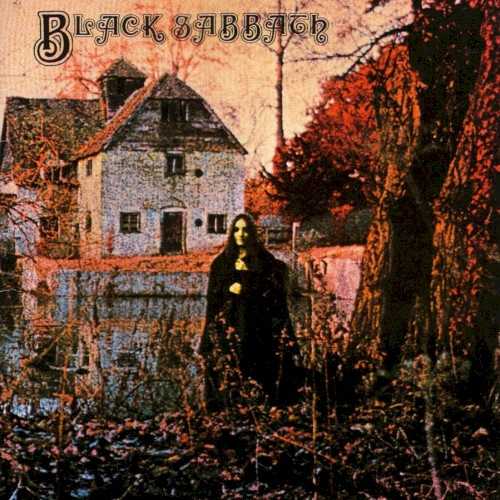 | Album: 1 of 42 Title: Black Sabbath Released: 1970-02-13 Tracks: 5 Duration: 39:28 Scroll: Up Down Top Bottom 25% 50% 75% Spotify Allmusic AlbumCover | 1 Black Sabbath (06:20) 2 The Wizard (04:23) 3 Wasp / Behind the Wall of Sleep / Bassically / N.I.B. (09:44) 4 Wicked World (04:44) 5 A Bit of Finger / Sleeping Village / Warning (14:15) |
| Black Sabbath : Allmusic album Review : Black Sabbaths debut album is the birth of heavy metal as we now know it. Compatriots like Blue Cheer, Led Zeppelin, and Deep Purple were already setting new standards for volume and heaviness in the realms of psychedelia, blues-rock, and prog rock. Yet of these metal pioneers, Sabbath are the only one whose sound today remains instantly recognizable as heavy metal, even after decades of evolution in the genre. Circumstance certainly played some role in the birth of this musical revolution -- the sonic ugliness reflecting the bleak industrial nightmare of Birmingham; guitarist Tony Iommis loss of two fingertips, which required him to play slower and to slacken the strings by tuning his guitar down, thus creating Sabbaths signature style. These qualities set the band apart, but they werent wholly why this debut album transcends its clear roots in blues-rock and psychedelia to become something more. Sabbaths genius was finding the hidden malevolence in the blues, and then bludgeoning the listener over the head with it. Take the legendary album-opening title cut. The standard pentatonic blues scale always added the tritone, or flatted fifth, as the so-called "blues note"; Sabbath simply extracted it and came up with one of the simplest yet most definitive heavy metal riffs of all time. Thematically, most of heavy metals great lyrical obsessions are not only here, theyre all crammed onto side one. "Black Sabbath," "The Wizard," "Behind the Wall of Sleep," and "N.I.B." evoke visions of evil, paganism, and the occult as filtered through horror films and the writings of J.R.R. Tolkien, H.P. Lovecraft, and Dennis Wheatley. Even if the album ended here, it would still be essential listening. Unfortunately, much of side two is given over to loose blues-rock jamming learned through Cream, which plays squarely into the bands limitations. For all his stylistic innovations and strengths as a composer, Iommi isnt a hugely accomplished soloist. By the end of the murky, meandering, ten-minute cover of the Aynsley Dunbar Retaliations "Warning," you can already hear him recycling some of the same simple blues licks he used on side one (plus, the word "warn" never even appears in the song, because Ozzy Osbourne misheard the original lyrics). (The British release included another cover, a version of Crows "Evil Woman" that doesnt quite pack the muscle of the bands originals; the American version substituted "Wicked World," which is much preferred by fans.) But even if the seams are still showing on this quickly recorded document, Black Sabbath is nonetheless a revolutionary debut whose distinctive ideas merely await a bit more focus and development. Henceforth Black Sabbath would forge ahead with a vision that was wholly theirs. | ||
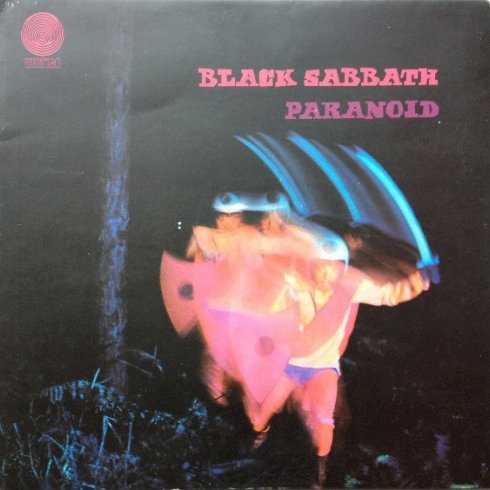 | Album: 2 of 42 Title: Paranoid Released: 1970-09-18 Tracks: 8 Duration: 41:48 Scroll: Up Down Top Bottom 25% 50% 75% Spotify Wikipedia Allmusic AlbumCover | 1 War Pigs / Luke’s Wall (07:56) 2 Paranoid (02:48) 3 Planet Caravan (04:26) 4 Iron Man (05:55) 5 Electric Funeral (04:49) 6 Hand of Doom (07:08) 7 Rat Salad (02:30) 8 Jack the Stripper / Fairies Wear Boots (06:14) |
| Paranoid : Allmusic album Review : Paranoid was not only Black Sabbaths most popular record (it was a number one smash in the U.K., and "Paranoid" and "Iron Man" both scraped the U.S. charts despite virtually nonexistent radio play), it also stands as one of the greatest and most influential heavy metal albums of all time. Paranoid refined Black Sabbaths signature sound -- crushingly loud, minor-key dirges loosely based on heavy blues-rock -- and applied it to a newly consistent set of songs with utterly memorable riffs, most of which now rank as all-time metal classics. Where the extended, multi-sectioned songs on the debut sometimes felt like aimless jams, their counterparts on Paranoid have been given focus and direction, lending an epic drama to now-standards like "War Pigs" and "Iron Man" (which sports one of the most immediately identifiable riffs in metal history). The subject matter is unrelentingly, obsessively dark, covering both supernatural/sci-fi horrors and the real-life traumas of death, war, nuclear annihilation, mental illness, drug hallucinations, and narcotic abuse. Yet Sabbath makes it totally convincing, thanks to the crawling, muddled bleakness and bad-trip depression evoked so frighteningly well by their music. Even the qualities that made critics deplore the album (and the group) for years increase the overall effect -- the technical simplicity of Ozzy Osbournes vocals and Tony Iommis lead guitar vocabulary; the spots when the lyrics sink into melodrama or awkwardness; the lack of subtlety and the infrequent dynamic contrast. Everything adds up to more than the sum of its parts, as though the anxieties behind the music simply demanded that the band achieve catharsis by steamrolling everything in its path, including its own limitations. Monolithic and primally powerful, Paranoid defined the sound and style of heavy metal more than any other record in rock history. | ||
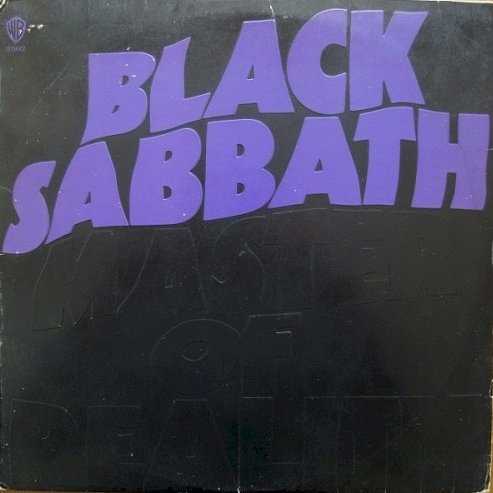 | Album: 3 of 42 Title: Master of Reality Released: 1971-07-21 Tracks: 17 Duration: 1:15:53 Scroll: Up Down Top Bottom 25% 50% 75% Spotify Wikipedia Allmusic AlbumCover | 1 Sweet Leaf (05:05) 2 After Forever (05:27) 3 Embryo (00:28) 4 Children of the Grave (05:17) 5 Orchid (01:31) 6 Lord of This World (05:26) 7 Solitude (05:02) 8 Into the Void (06:13) 1 Weevil Woman ’71 (02:59) 2 Sweet Leaf (studio outtake featuring alternative lyrics) (05:03) 3 After Forever (studio outtake – instrumental) (05:19) 4 Children of the Grave (studio outtake featuring alternative lyrics) (04:35) 5 Children of the Grave (studio outtake – instrumental) (06:01) 6 Orchid (studio outtake – with Tony count-in) (01:40) 7 Lord of This World (studio outtake featuring piano & slide guitar) (05:37) 8 Solitude (studio outtake – intro. with alternative guitar tuning) (03:45) 9 Into the Void “Spanish Sid” (studio outtake – alternative version) (06:23) |
| Master of Reality : Allmusic album Review : The shortest album of Black Sabbaths glory years, Master of Reality is also their most sonically influential work. Here Tony Iommi began to experiment with tuning his guitar down three half-steps to C#, producing a sound that was darker, deeper, and sludgier than anything theyd yet committed to record. (This trick was still being copied 25 years later by every metal band looking to push the limits of heaviness, from trendy nu-metallers to Swedish deathsters.) Much more than that, Master of Reality essentially created multiple metal subgenres all by itself, laying the sonic foundations for doom, stoner and sludge metal, all in the space of just over half an hour. Classic opener "Sweet Leaf" certainly ranks as a defining stoner metal song, making its drug references far more overt (and adoring) than the preceding albums "Fairies Wear Boots." The albums other signature song, "Children of the Grave," is driven by a galloping rhythm that would later pop up on a slew of Iron Maiden tunes, among many others. Aside from "Sweet Leaf," much of Master of Reality finds the band displaying a stronger moral sense, in part an attempt to counteract the growing perception that they were Satanists. "Children of the Grave" posits a stark choice between love and nuclear annihilation, while "After Forever" philosophizes about death and the afterlife in an openly religious (but, of course, superficially morbid) fashion that offered a blueprint for the career of Christian doom band Trouble. And although the alternately sinister and jaunty "Lord of This World" is sung from Satans point of view, he clearly doesnt think much of his own followers (and neither, by extension, does the band). Its all handled much like a horror movie with a clear moral message, for example The Exorcist. Past those four tracks, listeners get sharply contrasting tempos in the rumbling sci-fi tale "Into the Void," which shortens the distances between the multiple sections of the bands previous epics. And theres the core of the album -- all thats left is a couple of brief instrumental interludes, plus the quiet, brooding loneliness of "Solitude," a mostly textural piece that frames Osbournes phased vocals with acoustic guitars and flutes. But, if a core of five songs seems slight for a classic album, its also important to note that those five songs represent a nearly bottomless bag of tricks, many of which are still being imitated and explored decades later. If Paranoid has more widely known songs, the suffocating and oppressive Master of Reality was the Sabbath record that die-hard metalheads took most closely to heart. | ||
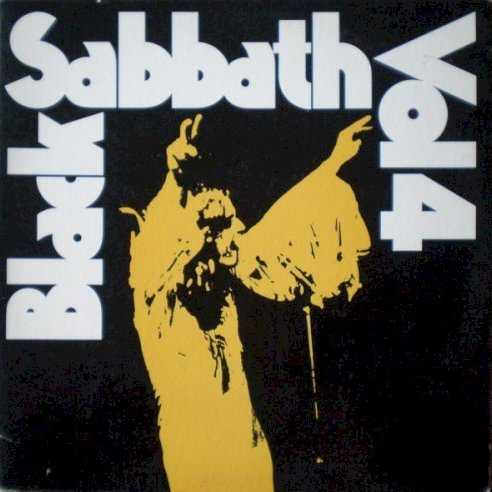 | Album: 4 of 42 Title: Vol 4 Released: 1972-09-25 Tracks: 11 Duration: 47:32 Scroll: Up Down Top Bottom 25% 50% 75% Spotify Wikipedia Allmusic AlbumCover | 1 Wheels of Confusion (08:02) 2 Tomorrow’s Dream (03:10) 3 Changes (04:44) 4 FX (01:43) 5 Supernaut (04:40) 6 Snowblind (05:29) 7 Cornucopia (03:54) 8 Laguna Sunrise (02:53) 9 St. Vitus’ Dance (02:29) 10 Under the Sun (05:51) 11 Children of the Grave (live) (04:35) |
| Vol 4 : Allmusic album Review : Vol. 4 is the point in Black Sabbaths career where the bands legendary drug consumption really starts to make itself felt. And it isnt just in the lyrics, most of which are about the blurry line between reality and illusion. Vol. 4 has all the messiness of a heavy metal Exile on Main St., and if it lacks that albums overall diversity, it does find Sabbath at their most musically varied, pushing to experiment amidst the drug-addled murk. As a result, there are some puzzling choices made here (not least of which is the inclusion of "FX"), and the album often contradicts itself. Ozzy Osbournes wail is becoming more powerful here, taking greater independence from Tony Iommis guitar riffs, yet his vocals are processed into a nearly textural element on much of side two. Parts of Vol. 4 are as ultra-heavy as Master of Reality, yet the band also takes its most blatant shots at accessibility to date -- and then undercuts that very intent. The effectively concise "Tomorrows Dream" has a chorus that could almost be called radio-ready, were it not for the fact that it only appears once in the entire song. "St. Vitus Dance" is surprisingly upbeat, yet the distant-sounding vocals dont really register. The notorious piano-and-Mellotron ballad "Changes" ultimately fails not because of its change-of-pace mood, but more for a raft of the most horrendously clichéd rhymes this side of "moon-June." Even the crushing "Supernaut" -- perhaps the heaviest single track in the Sabbath catalog -- sticks a funky, almost danceable acoustic breakdown smack in the middle. Besides "Supernaut," the core of Vol. 4 lies in the midtempo cocaine ode "Snowblind," which was originally slated to be the albums title track until the record company got cold feet, and the multi-sectioned prog-leaning opener, "Wheels of Confusion." The latter is one of Iommis most complex and impressive compositions, varying not only riffs but textures throughout its eight minutes. Many doom and stoner metal aficionados prize the second side of the album, where Osbournes vocals gradually fade further and further away into the murk, and Iommis guitar assumes center stage. The underrated "Cornucopia" strikes a better balance of those elements, but by the time "Under the Sun" closes the album, the lyrics are mostly lost under a mountain of memorable, contrasting riffery. Add all of this up, and Vol. 4 is a less cohesive effort than its two immediate predecessors, but is all the more fascinating for it. Die-hard fans sick of the standards come here next, and some end up counting this as their favorite Sabbath record for its eccentricities and for its embodiment of the bands excesses. | ||
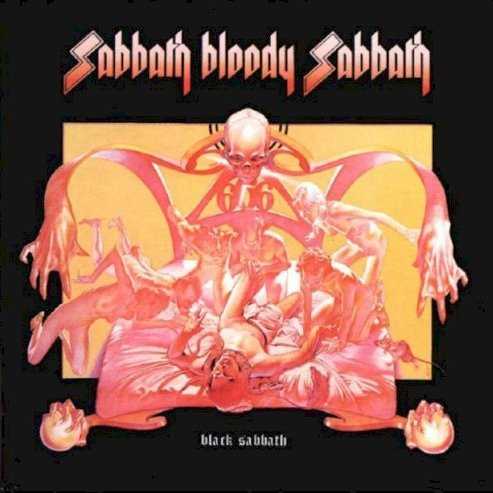 | Album: 5 of 42 Title: Sabbath Bloody Sabbath Released: 1973 Tracks: 8 Duration: 42:29 Scroll: Up Down Top Bottom 25% 50% 75% Spotify Wikipedia Allmusic AlbumCover | 1 Sabbath Bloody Sabbath (05:45) 2 A National Acrobat (06:13) 3 Fluff (04:09) 4 Sabbra Cadabra (05:57) 5 Killing Yourself to Live (05:41) 6 Who Are You? (04:10) 7 Looking for Today (05:01) 8 Spiral Architect (05:30) |
| Sabbath Bloody Sabbath : Allmusic album Review : With 1973s Sabbath Bloody Sabbath, heavy metal godfathers Black Sabbath made a concerted effort to prove their remaining critics wrong by raising their creative stakes and dispensing unprecedented attention to the albums production standards, arrangements, and even the cover artwork. As a result, bold new efforts like the timeless title track, "A National Acrobat," and "Killing Yourself to Live" positively glistened with a newfound level of finesse and maturity, while remaining largely faithful, aesthetically speaking, to the bands signature compositional style. In fact, their sheer songwriting excellence may even have helped to ease the transition for suspicious older fans left yearning for the rough-hewn, brute strength that had made recent triumphs like Master of Reality and Vol. 4 (really, all their previous albums) such undeniable forces of nature. But thanks to Sabbath Bloody Sabbaths nearly flawless execution, even a more adventurous experiment like the string-laden "Spiral Architect," with its tasteful background orchestration, managed to sound surprisingly natural, and in the dreamy instrumental "Fluff," Tony Iommi scored his first truly memorable solo piece. If anything, only the groups at times heavy-handed adoption of synthesizers met with inconsistent consequences, with erstwhile Yes keyboard wizard Rick Wakeman bringing only good things to the memorable "Sabbra Cadabra" (who know he was such a great boogie-woogie pianist?), while the robotically dull "Who Are You" definitely suffered from synthesizer novelty overkill. All things considered, though, Sabbath Bloody Sabbath was arguably Black Sabbaths fifth masterpiece in four years, and remains an essential item in any heavy metal collection. | ||
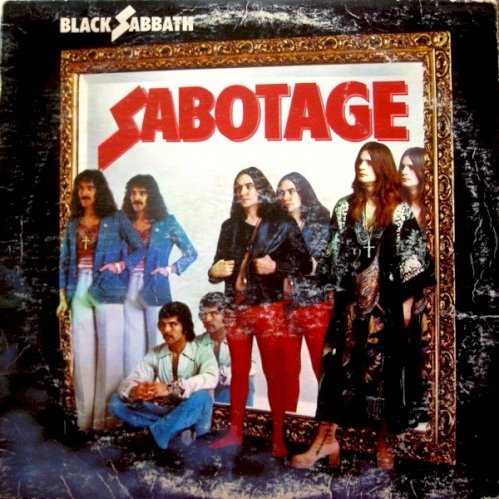 | Album: 6 of 42 Title: Sabotage Released: 1975-07-28 Tracks: 8 Duration: 43:06 Scroll: Up Down Top Bottom 25% 50% 75% Spotify Wikipedia Allmusic AlbumCover | 1 Hole in the Sky (04:00) 2 Don’t Start (Too Late) (00:49) 3 Symptom of the Universe (06:29) 4 Megalomania (09:42) 5 The Thrill of It All (05:55) 6 Supertzar (03:44) 7 Am I Going Insane (Radio) (04:16) 8 The Writ (08:10) |
| Sabotage : Allmusic album Review : Sabotage is the final release of Black Sabbaths legendary First Six, and its also the least celebrated of the bunch, though most die-hard fans would consider it criminally underrated. The band continues further down the proto-prog metal road of Sabbath Bloody Sabbath, and this time around, the synthesizers feel more organically integrated into the arrangements. Whats more, the song structures generally feel less conventional and more challenging. Theres one significant exception in the blatant pop tune "Am I Going Insane (Radio)," which rivals "Changes" as the most fan-loathed song of the glory years, thanks to its synth-driven arrangement (there isnt even a guitar riff!) and oft-repeated one-line chorus. But other than that song and the terrific album opener, "Hole in the Sky," the band largely eschews the standard verse-chorus format, sticking to one or two melody lines per riffed section and changing up the feel before things get too repetitive. The prevalence of this writing approach means that Sabotage rivals Vol. 4 as the least accessible record of Sabbaths glory years. However, given time, the compositional logic reveals itself, and most of the record will burn itself into the listeners brain just fine. The faster than usual "Symptom of the Universe" is a stone-cold classic, its sinister main riff sounding like the first seed from which the New Wave of British Heavy Metal would sprout (not to mention an obvious blueprint for Diamond Heads "Am I Evil?"). Like several songs on the record, "Symptom" features unexpected acoustic breaks and softer dynamics, yet never loses its drive or focus, and always feels like Sabbath. Less immediate but still rewarding are "Thrill of It All," with its triumphant final section, and the murky, sullen "Megalomania," which never feels as long as its nearly nine and a half minutes. But more than the compositions, the real revelation on Sabotage is Ozzy Osbourne, who turns in his finest vocal performance as a member of Black Sabbath. Really for the first time, this is the Ozzy we all know, displaying enough range, power, and confidence to foreshadow his hugely successful solo career. He saves the best for last with album closer "The Writ," one of the few Sabbath songs where his vocal lines are more memorable than Tony Iommis guitar parts; running through several moods over the course of the songs eight minutes, its one of the best performances of his career, bar none. Unfortunately, after Sabotage, the wheels of confusion came off entirely. Yes, there were technically two more albums, but for the non-obsessive, the story of Osbourne-era Sabbath effectively ends here. | ||
 | Album: 7 of 42 Title: We Sold Our Soul for Rock ’n’ Roll Released: 1975-12-01 Tracks: 15 Duration: 1:11:04 Scroll: Up Down Top Bottom 25% 50% 75% Spotify Wikipedia Allmusic AlbumCover | 1 Black Sabbath (06:20) 2 The Wizard (04:23) 3 Warning (03:31) 4 Paranoid (02:48) 5 War Pigs (07:58) 6 Iron Man (05:55) 7 Tomorrow’s Dream (03:10) 8 Fairies Wear Boots (06:11) 1 Changes (04:44) 2 Sweet Leaf (05:05) 3 Children of the Grave (00:43) 4 Sabbath Bloody Sabbath (05:45) 5 Laguna Sunrise (02:53) 6 Snowblind (05:29) 7 N.I.B. (06:06) |
| We Sold Our Soul for Rock ’n’ Roll : Allmusic album Review : We Sold Our Soul for Rock n Roll is a good single-disc collection of many -- but not all -- of Black Sabbaths best tracks from the Ozzy Osbourne era, drawing about half of its material from the groups first two albums, Black Sabbath and Paranoid. That makes it ideal for the fan who only wants one Black Sabbath disc, but those who want to dig deeper should be advised that all six LPs from the Osbourne period contain high-quality items not present here, especially the under-represented Master of Reality and Vol. 4. Still, theres no quibbling with what is here. | ||
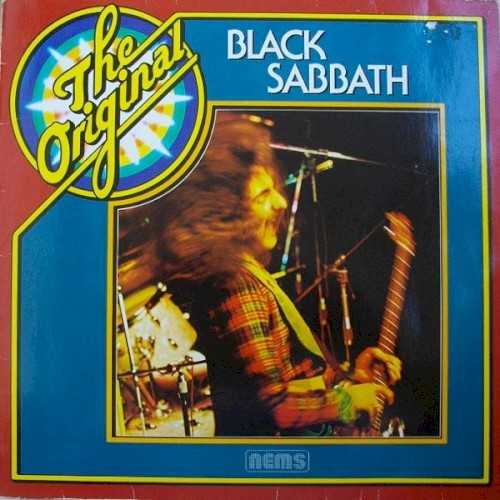 | Album: 8 of 42 Title: The Original Released: 1976 Tracks: 8 Duration: 38:58 Scroll: Up Down Top Bottom 25% 50% 75% AlbumCover | 1 Paranoid (02:47) 2 N.I.B. (05:26) 3 Changes (04:48) 4 Sabbath Bloody Sabbath (05:45) 5 Black Sabbath (06:15) 6 War Pigs / Luke’s Wall (07:56) 7 Laguna Sunrise (02:52) 8 Tomorrows Dream (03:09) |
 | Album: 9 of 42 Title: Technical Ecstasy Released: 1976-09-25 Tracks: 8 Duration: 40:39 Scroll: Up Down Top Bottom 25% 50% 75% Spotify Allmusic AlbumCover | 1 Back Street Kids (03:49) 2 You Won’t Change Me (06:44) 3 It’s Alright (04:06) 4 Gypsy (05:11) 5 All Moving Parts (Stand Still) (05:06) 6 Rock ’n’ Roll Doctor (03:34) 7 She’s Gone (04:57) 8 Dirty Women (07:10) |
| Technical Ecstasy : Allmusic album Review : Black Sabbath was unraveling at an alarming rate around the time of their second to last album with original singer Ozzy Osbourne, 1976s Technical Ecstasy. The band was getting further and further from their original musical path, as they began experimenting with their trademark sludge-metal sound. While it was not as off-the-mark as their final album with Osbourne, 1978s Never Say Die, it was not on par with Sabbaths exceptional first five releases. The most popular song remains the album closer, "Dirty Women," which was revived during the bands highly successful reunion tour of the late 90s. Other standouts include the funky "All Moving Parts (Stand Still)" and the raging opener, "Back Street Kids." The melodic "Its Alright" turns out to be the albums biggest surprise -- its one of drummer Bill Wards few lead vocal spots with the band (Guns N Roses covered the unlikely track on their 1999 live set, Live Era 1987-1993). | ||
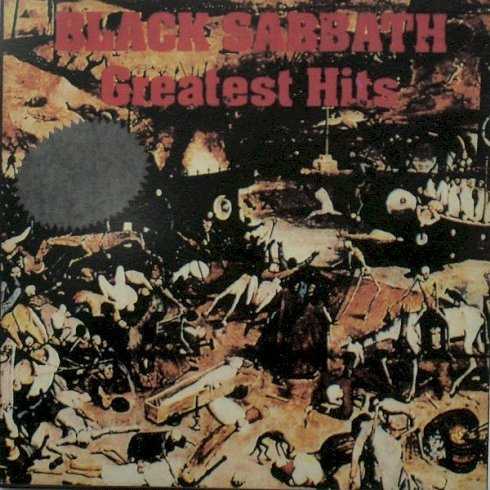 | Album: 10 of 42 Title: Greatest Hits Released: 1977 Tracks: 10 Duration: 50:37 Scroll: Up Down Top Bottom 25% 50% 75% Spotify AlbumCover | 1 Paranoid (02:48) 2 N.I.B. (06:06) 3 Changes (04:44) 4 Sabbath Bloody Sabbath (05:45) 5 Iron Man (05:55) 6 Black Sabbath (06:20) 7 War Pigs / Luke’s Wall (07:56) 8 Laguna Sunrise (02:47) 9 Tomorrow’s Dream (03:10) 10 Sweet Leaf (05:05) |
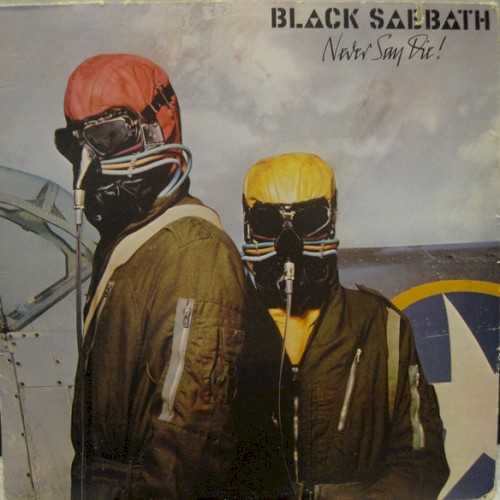 | Album: 11 of 42 Title: Never Say Die! Released: 1978-09-28 Tracks: 9 Duration: 45:48 Scroll: Up Down Top Bottom 25% 50% 75% Spotify Allmusic AlbumCover | 1 Never Say Die (03:49) 2 Johnny Blade (06:28) 3 Junior’s Eyes (06:42) 4 A Hard Road (06:06) 5 Shock Wave (05:16) 6 Air Dance (05:17) 7 Over to You (05:24) 8 Breakout (02:35) 9 Swinging the Chain (04:07) |
| Never Say Die! : Allmusic album Review : After going their separate ways for a brief period following the emotionally taxing and drug-infested Technical Ecstasy tour, Black Sabbath and singer Ozzy Osbourne reconciled long enough to record 1978s Never Say Die! -- an album whose varied but often unfocused songs perfectly reflected the bands uneasy state of affairs at the time. Even the surprisingly energetic title track, which seemed to kick things off with a promising bang, couldnt entirely mask the groups fading enthusiasm just beneath the surface after a few repeated listens. The same was true of half-hearted performances like "Shock Wave" and "Over to You," and there were several songs on the record that sound strangely disjointed, specifically "Juniors Eyes" and the synthesizer-doused "Johnny Blade" -- as though their creation came in fits and starts, rather than through cohesive band interaction. But when it came to wild, stylistic departures, ones disappointing realization that the lurching, saxophone-led "Breakout" came from -- and then went back to -- absolutely nowhere was easily offset by the stunningly successful oddity that was "Air Dance." Arguably the most experimental song in Black Sabbaths entire canon, this uncharacteristically mild-mannered and effortlessly evocative ballad saw Tony Iommis normally bullish guitar giving way to simply mesmerizing piano flourishes performed by leading session keyboardist Don Airey. If only it had represented a bold new direction (albeit one that die-hard fans would never have accepted) rather than just another sign of the bands quickly fraying sense of identity, Black Sabbaths original lineup may have found a way to save itself -- but Never Say Die!s incoherent musical aggregate in fact betrayed the harsh reality that it was indeed too late. So even though those same die-hard Black Sabbath fans and completists will likely find some redeeming value in Never Say Die! after all these years, the original lineups final gasp will hold little interest to the average heavy metal fan. | ||
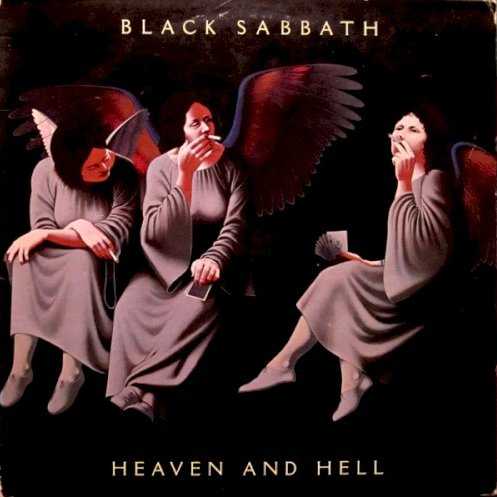 | Album: 12 of 42 Title: Heaven and Hell Released: 1980-04-25 Tracks: 8 Duration: 39:53 Scroll: Up Down Top Bottom 25% 50% 75% Spotify Wikipedia Allmusic AlbumCover | 1 Neon Knights (03:53) 2 Children of the Sea (05:34) 3 Lady Evil (04:24) 4 Heaven and Hell (06:57) 5 Wishing Well (04:07) 6 Die Young (04:45) 7 Walk Away (04:25) 8 Lonely Is the Word (05:46) |
| Heaven and Hell : Allmusic album Review : Many had left Black Sabbath for dead at the dawn of the 80s, and with good reason -- the bands last few albums were not even close to their early classics, and original singer Ozzy Osbourne had just split from the band. But the Sabs had found a worthy replacement in former Elf and Rainbow singer Ronnie James Dio, and bounced back to issue their finest album since the early 70s, 1980s Heaven and Hell. The band sounds reborn and re-energized throughout. Several tracks easily rank among Sabbaths all-time best, such as the vicious album opener, "Neon Knights," the moody, mid-paced epic "Children of the Sea," and the title track, which features one of Tony Iommi s best guitar riffs. With Heaven and Hell, Black Sabbath were obviously back in business. Unfortunately, the Dio-led version of the band would only record one more studio album before splitting up (although Dio would return briefly in the early 90s). One of Sabbaths finest records. | ||
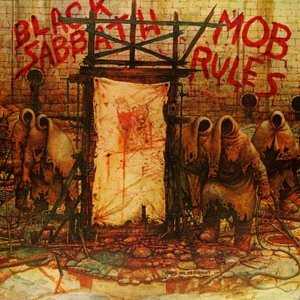 | Album: 13 of 42 Title: Mob Rules Released: 1981-11-04 Tracks: 9 Duration: 40:32 Scroll: Up Down Top Bottom 25% 50% 75% Spotify Wikipedia Allmusic AlbumCover | 1 Turn Up the Night (03:42) 2 Voodoo (04:33) 3 The Sign of the Southern Cross (07:47) 4 E5150 (02:51) 5 The Mob Rules (03:15) 6 Country Girl (04:02) 7 Slipping Away (03:46) 8 Falling Off the Edge of the World (05:04) 9 Over and Over (05:28) |
| Mob Rules : Allmusic album Review : 1981s Mob Rules was the second Black Sabbath album to feature vertically challenged singer Ronnie James Dio, whose powerful pipes and Dungeons and Dragons lyrics initially seemed like the perfect replacement for the recently departed and wildly popular Ozzy Osbourne. In fact, all the ingredients which had made their first outing, Heaven and Hell, so successful are re-utilized on this album, including legendary metal producer Martin Birch (Deep Purple, Whitesnake, etc.) and supporting keyboard player Geoff Nichols. And while it lacks some of its predecessors inspired songwriting, Mob Rules was given a much punchier, in-your-face mix by Birch, who seemed re-energized after his work on New Wave of British Heavy Metal upstarts Iron Maidens Killers album. Essentially, Mob Rules is a magnificent record, with the only serious problem being the sequencing of the material, which mirrors Heaven and Hells almost to a tee. In that light, one cant help but compare otherwise compelling tracks like "Turn Up the Night" and "Voodoo" to their more impressive Heaven and Hell counterparts, "Neon Knights" and "Children of the Sea." That streak is soon snapped, first by the unbelievably heavy seven-minute epic "The Sign of the Southern Cross," which delivers one of the albums best moments, then its segue into an unconventional synthesizer-driven instrumental ("E5150") and the appearance of the roaring title track. Side two is less consistent, hiding the awesome "Falling off the Edge of the World" (perhaps the most overlooked secret gem to come from the Dio lineup) amongst rather average tracks like "Slipping Away" and "Over and Over." Over the next year, the wheels fell off for Black Sabbath, and Dios exit marked Mob Rules as the last widely respected studio release of the bands storied career. | ||
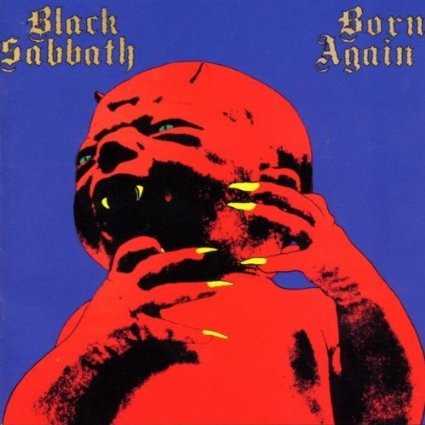 | Album: 14 of 42 Title: Born Again Released: 1983-08-07 Tracks: 9 Duration: 41:06 Scroll: Up Down Top Bottom 25% 50% 75% Spotify Wikipedia Allmusic AlbumCover | 1 Trashed (04:16) 2 Stonehenge (01:58) 3 Disturbing the Priest (05:49) 4 The Dark (00:45) 5 Zero the Hero (07:35) 6 Digital Bitch (03:39) 7 Born Again (06:34) 8 Hot Line (04:52) 9 Keep It Warm (05:35) |
| Born Again : Allmusic album Review : The idea sure looked good on paper, but when former Deep Purple frontman Ian Gillan joined Black Sabbath for 1983s dreadful Born Again album, the grim reality was that Gillans bluesy vocal style and oftentimes humorous lyrics were completely incompatible with the lords of doom and gloom. Widely deemed the bands creative nadir (although a few later efforts like Cross Purposes and Forbidden give it a run for its money), Born Again also featured one of the worst album covers ever (its been voted!), and the subsequent world tour was so troubled and tragicomic that the bands Stonehenge stage set wound up serving as inspiration for the ultimate rock & roll spoof movie, This Is Spinal Tap, when it was discovered to be too large to fit inside most venues! Born Agains equally atrocious "production" leaves one with the distinct impression that, in a misguided attempt to record the heaviest album ever, Black Sabbath came away with the muddiest instead. Among the smoking ruins that pass for its songs, one might find it possible to appreciate Gillans trademarked double entendres on "Disturbing the Priest," pick out a decent melody within the messy title track, and get down to some mercifully straightforward headbanging with "Digital Bitch" and the albums lone classic, "Trashed." But the remaining detritus, composed of embarrassing numbers like "Zero the Hero," "Hot Line," and "Keep It Warm" and pointless sound effect interludes "Stonehenge" and "The Dark," is simply beyond painful. By comparison, even the barely-recognizable-as-Sabbath material found on 1986s belated comeback, Seventh Star -- originally planned as a Tony Iommi solo effort, to be fair -- sounds pretty damn good. But by then, Black Sabbaths greatly anticipated association with Ian Gillan had gone down as one of heavy metals all-time greatest disappointments, and nearly killed the genres founding fathers in the process. | ||
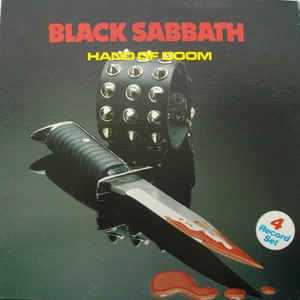 | Album: 15 of 42 Title: Hand of Doom Released: 1984 Tracks: 33 Duration: 2:38:06 Scroll: Up Down Top Bottom 25% 50% 75% AlbumCover | 1 Black Sabbath (06:20) 2 The Wizard (04:23) 3 Behind the Wall of Sleep (03:37) 4 N.I.B. (06:06) 5 Evil Woman (Don’t Play Your Games With Me) (03:24) 6 Sleeping Village (10:44) 7 Warning (03:31) 1 War Pigs / Luke’s Wall (07:56) 2 Paranoid (02:43) 3 Planet Caravan (04:35) 4 Iron Man (05:55) 5 Electric Funeral (04:53) 6 Hand of Doom (07:10) 7 Rat Salad (02:29) 8 Jack the Stripper / Fairies Wear Boots (06:14) 1 Sweet Leaf (05:05) 2 After Forever (05:27) 3 Embryo (00:28) 4 Children of the Grave (05:17) 5 Orchid (01:31) 6 Lord of This World (05:26) 7 Solitude (05:02) 8 Into the Void (06:13) 1 Wheels of Confusion (08:09) 2 Tomorrows Dream (03:06) 3 Changes (04:41) 4 FX (01:38) 5 Supernaut (04:42) 6 Snowblind (05:25) 7 Cornucopia (04:48) 8 Lagune Sunrise (02:49) 9 St. Vitus Dance (02:24) 10 Under the Sun (05:49) |
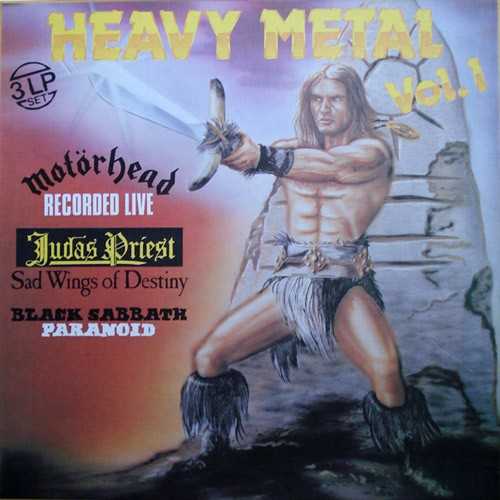 | Album: 16 of 42 Title: Heavy Metal Vol. 1 Released: 1984 Tracks: 26 Duration: 1:56:32 Scroll: Up Down Top Bottom 25% 50% 75% AlbumCover | 1 The Watcher (04:06) 2 Iron Horse / Born to Lose (05:05) 3 On Parole (05:30) 4 White Line Fever (02:34) 5 Keep Us on the Road (05:25) 6 Leaving Here (03:12) 7 Im Your Witch Doctor (03:08) 8 The Train Kept a Rollin (02:50) 9 City Kids (03:38) 1 Victim of Changes (07:45) 2 The Ripper (02:51) 3 Dreamer Deceiver (05:53) 4 Deceiver (02:46) 5 Prelude (02:02) 6 Tyrant (04:28) 7 Genocide (05:48) 8 Epitaph (03:20) 9 Island of Domination (04:20) 1 War Pigs / Luke’s Wall (07:56) 2 Paranoid (02:48) 3 Planet Caravan (04:26) 4 Iron Man (05:55) 5 Electric Funeral (04:49) 6 Hand of Doom (07:08) 7 Rat Salad (02:30) 8 Jack the Stripper / Fairies Wear Boots (06:14) |
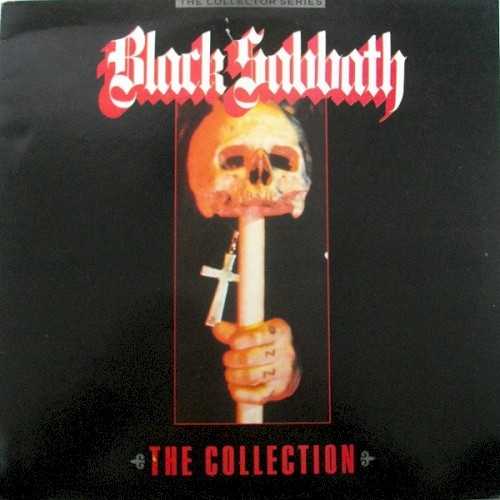 | Album: 17 of 42 Title: The Sabbath Collection Released: 1985 Tracks: 11 Duration: 58:56 Scroll: Up Down Top Bottom 25% 50% 75% Spotify Wikipedia AlbumCover | 1 Paranoid (02:48) 2 Behind the Wall of Sleep (04:22) 3 Sleeping Village (10:44) 4 Warning (03:31) 5 After Forever (05:27) 6 Supernaut (04:40) 7 St. Vitus’ Dance (02:29) 8 Snowblind (05:29) 9 Killing Yourself to Live (05:41) 10 Sabbra Cadabra (05:57) 11 The Writ (07:45) |
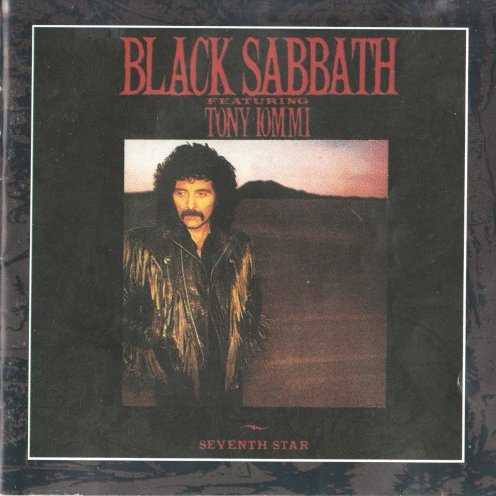 | Album: 18 of 42 Title: Seventh Star Released: 1986-01-28 Tracks: 9 Duration: 35:00 Scroll: Up Down Top Bottom 25% 50% 75% Spotify Allmusic AlbumCover | 1 In for the Kill (03:42) 2 No Stranger to Love (04:29) 3 Turn to Stone (03:29) 4 Sphinx (The Guardian) (01:12) 5 Seventh Star (05:20) 6 Danger Zone (04:26) 7 Heart Like a Wheel (06:37) 8 Angry Heart (03:06) 9 In Memory… (02:36) |
| Seventh Star : Allmusic album Review : An often misunderstood and underrated album, 1986s Seventh Star was never intended to be a Black Sabbath release, as the band had effectively broken up following its disastrous 1984 tour in support of career low point Born Again. Instead, Seventh Star was conceived as guitarist Tony Iommis first solo project, and it was only record company pressure that forced him to resurrect his longtime bands moniker at the last minute. With this in mind, one can better appreciate both the records more blues-based, often un-Sabbath-like songwriting and the contributions made by journeyman singer Glenn Hughes (ex-Trapeze, Deep Purple, etc.), whose incredibly emotive and soulful vocal style was completely at odds with the deadpan delivery of Sabbaths most recognizable singer, Ozzy Osbourne (a discrepancy that would spell his quick exit when the necessary classics were wheeled out for the ensuing world tour). Still, within the unique circumstances of Seventh Stars creation, Hughes fiery tunefulness made aggressive hard rockers like "In for the Kill," "Turn to Stone," and "Danger Zone" uncommonly catchy, and gorgeous ballads such as "Angry Heart/In Memory..." and "No Stranger to Love" all the more heart-rending. Tellingly, his efforts fell resoundingly flat on the bluesy aimlessness of "Heart Like a Wheel" and the gothic menace of the title track, making it possible for keener observers to foresee the troubles ahead. Yet, in light of the even more traumatic difficulties that preceded it, Seventh Star -- for all its uncharacteristic sonic qualities -- actually represents the turning of a corner for Black Sabbaths lengthy career, which steadily regained momentum in the years that followed. | ||
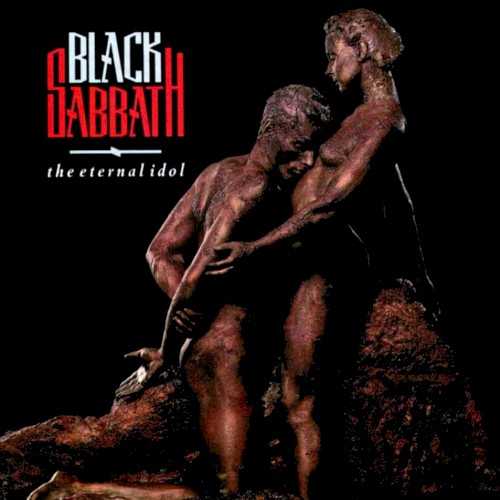 | Album: 19 of 42 Title: The Eternal Idol Released: 1987-11-01 Tracks: 9 Duration: 43:10 Scroll: Up Down Top Bottom 25% 50% 75% Spotify Allmusic AlbumCover | 1 The Shining (05:59) 2 Ancient Warrior (05:31) 3 Hard Life to Love (05:00) 4 Glory Ride (04:48) 5 Born to Lose (03:44) 6 Nightmare (05:20) 7 Scarlet Pimpernel (02:07) 8 Lost Forever (04:03) 9 Eternal Idol (06:34) |
| The Eternal Idol : Allmusic album Review : After years of playing a dispiriting game of musical chairs with various lead singers during the early 80s, Black Sabbath guitarist Tony Iommi finally stumbled upon a dependable frontman when he admitted relative unknown Tony Martin into the fold, thereby initiating the original heavy metal bands long awaited return to respectability -- if not chart-topping success. Martin joined the oft-interrupted sessions for what would become 1987s The Eternal Idol album already in progress, stepping in for an unreliable Ray Gillen when the latter moved on to Jake E. Lees Badlands, and helping Iommi rescue an astonishingly solid long-player from the jaws of complete and utter chaos. As it turned out, Martins powerful, muscular voice -- though bearing more than a passing resemblance to former singer Ronnie James Dio -- was ultimately the perfect foil for full-bodied heavy metal anthems like "Hard Life to Love," "Glory Ride," and "Born to Lose," which were built upon some of Iommis heaviest, most undeniable riffs of the decade. A hodgepodge of temporary backing musicians and short-lived producers somehow manage to fill in the gaps, and make The Eternal Idol sound like a very cohesive LP. If anything, however, its the ever-reliable Geoff Nicholls who embodies a third pillar of stability, by adding impeccable supporting keyboards throughout -- most notably to "Ancient Warrior" and the fantastically gloomy title track. And above all else, The Eternal Idol contains a bona fide heavy metal classic for the ages in its monumental opener, "The Shining," which Iommi had been kicking around in demo form since 1984, and which, in its final glorious form, is rightfully considered one of Black Sabbaths greatest songs bar none, regardless of singer, era, or album sales. In tandem with the consistently stellar songwriting all around, theres no denying The Eternal Idols standing as quite possibly Black Sabbaths most underrated opus, and arguably their best without either Ozzy Osbourne or Ronnie Dio at the microphone. | ||
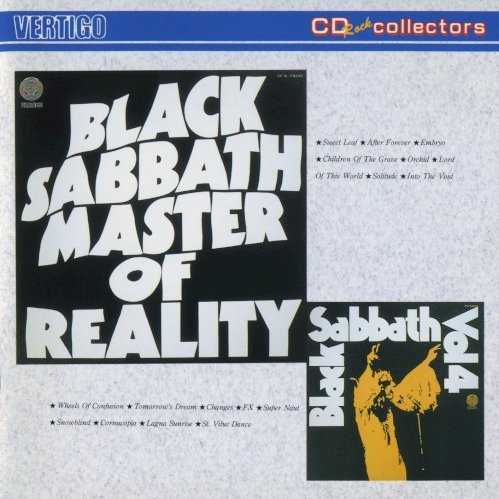 | Album: 20 of 42 Title: Master Of Reality / Black Sabbath Vol.4 Released: 1987-11-15 Tracks: 17 Duration: 1:11:41 Scroll: Up Down Top Bottom 25% 50% 75% AlbumCover | 1 Sweet Leaf (05:05) 2 After Forever (05:27) 3 Embryo (00:28) 4 Children of the Grave (05:14) 5 Orchid (01:33) 6 Lord of This World (05:24) 7 Solitude (05:02) 8 Into the Void (06:13) 9 Wheels of Confusion (08:02) 10 Tomorrows Dream (03:14) 11 Changes (04:44) 12 FX (01:43) 13 Super Naut (04:44) 14 Snowblind (05:29) 15 Cornucopia (03:54) 16 Laguna Sunrise (02:53) 17 St. Vitus’ Dance (02:29) |
 | Album: 21 of 42 Title: Paranoid / Black Sabbath Released: 1987-12-05 Tracks: 13 Duration: 1:05:40 Scroll: Up Down Top Bottom 25% 50% 75% Spotify AlbumCover | 1 War Pigs / Luke’s Wall (07:56) 2 Paranoid (02:48) 3 Planet Caravan (04:26) 4 Iron Man (05:55) 5 Electric Funeral (04:49) 6 Hand of Doom (07:08) 7 Rat Salad (02:30) 8 Jack the Stripper / Fairies Wear Boots (06:14) 9 Black Sabbath (06:20) 10 The Wizard (04:23) 11 Behind the Wall of Sleep (03:37) 12 N.I.B. (06:06) 13 Evil Woman (Don’t Play Your Games With Me) (03:24) |
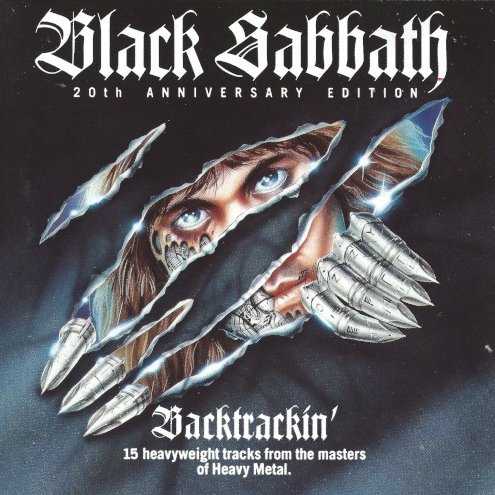 | Album: 22 of 42 Title: Backtrackin’ Released: 1989 Tracks: 15 Duration: 1:17:41 Scroll: Up Down Top Bottom 25% 50% 75% AlbumCover | 1 Paranoid (02:48) 2 Killing Yourself to Live (05:41) 3 Snowblind (05:29) 4 Sweet Leaf (05:05) 5 Sabbath Bloody Sabbath (05:45) 6 Symptom of the Universe (06:29) 7 Planet Caravan (04:26) 8 War Pigs / Luke’s Wall (07:56) 9 Into the Void (06:13) 10 Electric Funeral (04:48) 11 Sabbra Cadabra (05:57) 12 St. Vitus’ Dance (02:29) 13 Jack the Stripper / Fairies Wear Boots (06:14) 14 The Wizard (04:23) 15 Cornucopia (03:54) |
 | Album: 23 of 42 Title: Headless Cross Released: 1989-06-07 Tracks: 8 Duration: 40:27 Scroll: Up Down Top Bottom 25% 50% 75% Wikipedia Allmusic AlbumCover | 1 The Gates of Hell (01:06) 2 Headless Cross (06:29) 3 Devil and Daughter (04:44) 4 When Death Calls (06:55) 5 Kill In The Spirit World (05:11) 6 Call of the Wild (05:19) 7 Black Moon (04:06) 8 Nightwing (06:37) |
| Headless Cross : Allmusic album Review : By the late 80s everyone had pretty much given up on Black Sabbath...and why not? After all, guitarist Tony Iommi was the only remaining original member, and the band had seen an outrageous number of musicians -- particularly lead singers -- crash through its battered ranks since Ozzy Osbournes late-70s sacking. So it was actually quite a shock to anyone still paying attention when no-name vocalist Tony Martin outperformed a string of higher-profile predecessors with his contributions to Sabbaths unexpected 1987 return to form, The Eternal Idol, then pulled off the even more remarkable feat of being invited back for a second go-round via 1989s equally satisfying Headless Cross. Arguably the finest Black Sabbath album sans Ozzy or Dio, Headless Cross also featured one of Black Sabbaths most formidable lineups ever: matching the two Tonys with veteran bassist Neil Murray (Whitesnake, Gary Moore, etc.) and experienced journeyman Cozy Powell (too many associations to list) -- one of the few drummers in possession of an instantly recognizable sound. Its Powell, in fact, who leads the Sabs back out to the battlefield when he detonates the reverie of atmospheric intro "The Gates of Hell" with his echoing, pounding war drums, but naturally everything on offer is ultimately bound to, and dependent upon, Iommis almighty riffs -- from whence all rivers flow. This includes morbid monster-pieces such as "Kill in the Spirit World" and "Call of the Wild," which quake with simply massive power chords yet still manage to flow seamlessly into slightly more upbeat radio-friendly numbers like "Devil and Daughter" and "Black Moon." Likewise, whereas "When Death Calls" is surely one of Iommis most spine-chilling compositions ever in terms of sheer malevolent force, the equally bewitching "Nightwing" flips the coin entirely with its delicate acoustic guitars and (dare it be said) highly romantic lyrics. In short, for those wise enough to appreciate Black Sabbaths discography beyond the Osbourne and Dio essentials, there can be no better place to start than Headless Cross or its worthy predecessor, The Eternal Idol. | ||
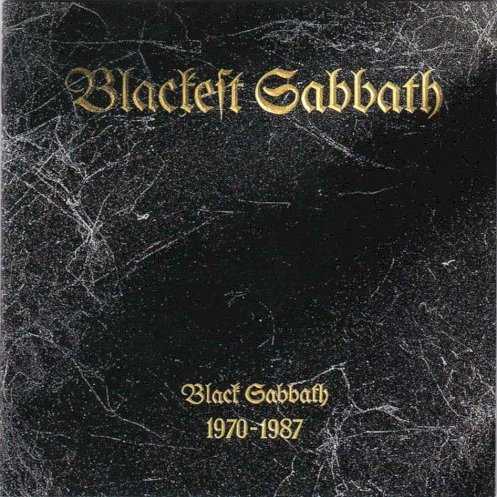 | Album: 24 of 42 Title: Blackest Sabbath Released: 1989-11 Tracks: 15 Duration: 1:11:40 Scroll: Up Down Top Bottom 25% 50% 75% AlbumCover | 1 Black Sabbath (06:20) 2 Paranoid (02:48) 3 Iron Man (05:55) 4 Snowblind (05:17) 5 Sabbath Bloody Sabbath (05:45) 6 Hole in the Sky (04:00) 7 Rock & Roll Doctor (03:27) 8 Never Say Die (03:49) 9 Lady Evil (04:24) 10 Turn Up the Night (03:42) 11 The Sign of the Southern Cross / Heaven & Hell (07:18) 12 Children of the Sea (live) (06:06) 13 Digital Bitch (03:39) 14 Seventh Star (05:20) 15 Born to Lose (03:44) |
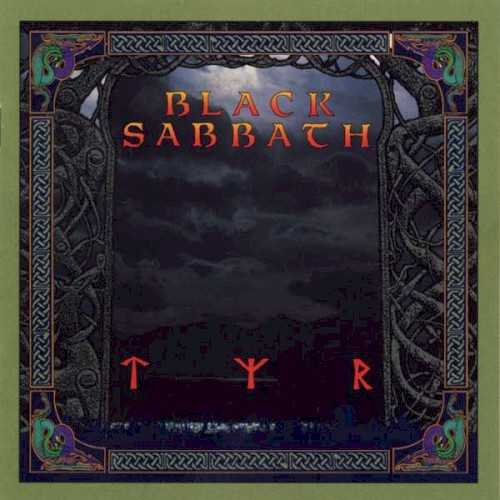 | Album: 25 of 42 Title: ᛏᛉᚱ Released: 1990-06 Tracks: 9 Duration: 39:19 Scroll: Up Down Top Bottom 25% 50% 75% Wikipedia Allmusic AlbumCover | 1 Anno Mundi (The Vision) (06:12) 2 The Law Maker (03:55) 3 Jerusalem (03:59) 4 The Sabbath Stones (06:48) 5 The Battle of Tyr (01:08) 6 Odin’s Court (02:42) 7 Valhalla (04:42) 8 Feels Good to Me (05:44) 9 Heaven in Black (04:05) |
| ᛏᛉᚱ : Allmusic album Review : Gothic in approach, but crushing guitar riffs galore, Tyr followed Black Sabbaths previous return to the spotlight by less than a year. Again leaning heavily on the darker side of life, or perhaps, death, Tyr is a set of tunes loosely based around the Norse tales of Odin and the gods of war. "Valhalla" is unlike anything the old Sabbath tried, yet still sounds familiar. "The Sabbath Stones" mix myth with metal in a crushing display of musical synthesis. With Tyr, Black Sabbath sound as serious as can be. | ||
 | Album: 26 of 42 Title: The Ozzy Osbourne Years Released: 1991-10-23 Tracks: 41 Duration: 3:44:27 Scroll: Up Down Top Bottom 25% 50% 75% Allmusic Wikipedia AlbumCover | 1 Black Sabbath (06:20) 2 The Wizard (04:23) 3 Behind the Wall of Sleep (03:37) 4 N.I.B. (06:06) 5 Evil Woman (Don’t Play Your Games With Me) (03:24) 6 Sleeping Village (10:44) 7 Warning (03:31) 8 War Pigs / Luke’s Wall (07:56) 9 Paranoid (02:48) 10 Planet Caravan (04:26) 11 Iron Man (05:55) 12 Hand of Doom (07:08) 13 Jack the Stripper / Fairies Wear Boots (06:14) 1 Electric Funeral (04:48) 2 Sweet Leaf (05:05) 3 After Forever (05:27) 4 Embryo (05:01) 5 Lord of This World (05:26) 6 Solitude (05:02) 7 Into the Void (06:13) 8 Wheels of Confusion (08:02) 9 Tomorrow’s Dream (03:10) 10 Changes (04:44) 11 Supernaut (04:40) 12 Snowblind (05:29) 13 Cornucopia (03:54) 14 St. Vitus’ Dance (02:29) 15 Under the Sun (05:49) 1 Sabbath Bloody Sabbath (05:45) 2 A National Acrobat (06:13) 3 Sabbra Cadabra (05:57) 4 Killing Yourself to Live (05:41) 5 Who Are You? (04:10) 6 Looking for Today (05:01) 7 Spiral Architect (05:30) 8 Hole in the Sky (04:00) 9 Symptom of the Universe (06:29) 10 Am I Going Insane (Radio) (04:16) 11 Thrill of It All (05:54) 12 Megalomania (09:42) 13 The Writ (07:45) |
| The Ozzy Osbourne Years : Allmusic album Review : This import, three-CD box set collects Black Sabbaths first six albums in near-entirety, excising a few lesser tracks and shorter instrumental pieces like "Laguna Sunrise," the only track from We Sold Our Soul for Rock n Roll not present ("Children of the Grave" is here, but mistitled "Embryo," which is actually its instrumental introduction). The tracks are ordered chronologically, often in their original LP sequence. It isnt as necessary to hear Sabbaths albums in their original forms as, for example, Led Zeppelins, so if you can find it, this set is a less expensive (and definitive) way to acquire all of Black Sabbaths worthwhile material at once. | ||
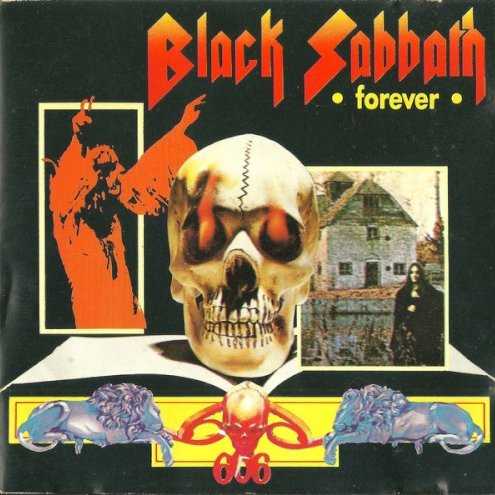 | Album: 27 of 42 Title: Forever Released: 1992 Tracks: 13 Duration: 1:12:07 Scroll: Up Down Top Bottom 25% 50% 75% AlbumCover | 1 Paranoid (02:49) 2 Iron Man (05:53) 3 War Pigs / Luke’s Wall (07:56) 4 N.I.B. (06:06) 5 Black Sabbath (06:19) 6 Under the Sun (05:54) 7 Supernaut (04:40) 8 The Wizard (04:23) 9 Sabbath Bloody Sabbath (05:45) 10 Sweet Leaf (05:05) 11 Sabbra Cadabra (05:57) 12 Symptom of the Universe (06:34) 13 Changes (04:41) |
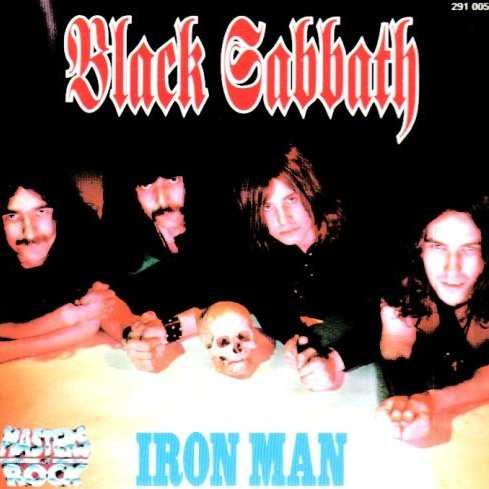 | Album: 28 of 42 Title: Iron Man Released: 1992 Tracks: 12 Duration: 59:37 Scroll: Up Down Top Bottom 25% 50% 75% AlbumCover | 1 Paranoid (02:48) 2 Iron Man (05:55) 3 Electric Funeral (04:48) 4 The Wizard (04:23) 5 Tomorrow’s Dream (03:10) 6 Sweet Leaf (05:05) 7 Under the Sun (05:51) 8 Evil Woman (Don’t Play Your Games With Me) (03:24) 9 N.I.B. (06:06) 10 Sabbath Bloody Sabbath (05:45) 11 Sabbra Cadabra (05:57) 12 Black Sabbath (06:20) |
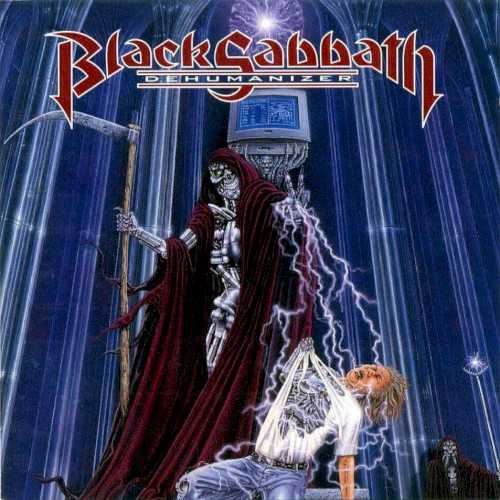 | Album: 29 of 42 Title: Dehumanizer Released: 1992-06-22 Tracks: 18 Duration: 1:31:30 Scroll: Up Down Top Bottom 25% 50% 75% Spotify Allmusic AlbumCover | 1 Computer God (06:14) 2 After All (The Dead) (05:41) 3 TV Crimes (04:02) 4 Letters From Earth (04:16) 5 Master of Insanity (05:55) 6 Time Machine (04:15) 7 Sins of the Father (04:46) 8 Too Late (06:54) 9 I (05:13) 10 Buried Alive (04:50) 1 Master of Insanity (single edit) (04:08) 2 Letters From Earth (alternative version) (04:41) 3 Time Machine (Wayne’s World version) (04:18) 4 Children of the Sea (06:23) 5 Die Young (02:16) 6 TV Crimes (04:23) 7 Master of Insanity (07:39) 8 Neon Knights (05:34) |
| Dehumanizer : Allmusic album Review : Sabbath and Dio were dealing with a dwindling fan base, unsuccessful albums, and a longstanding creative rut when they decided to reunite the Mob Rules lineup. In a perfect world, they would have created a monster of an album and shot back into the limelight with a vengeance. But with ten-year-old internal tensions still gnawing away at the band, they hastily created Dehumanizer, a weird side note in their long history. Ronnie James Dio delivers his strongest performance since the early 80s, and hearing Geezer Butler and Tony Iommi play together after nine years is inspiring. But they cannot seem to overcome the challenge of crafting classic Sabbath material, and it is this issue that haunts the recording from moment one. "Sins of the Father" is a good example; they attempt a "Children of the Sea"-type slow jam with the same ringing guitar and up-tempo vocals, but the hook is just not there and the band sounds like its creative wheels are spinning in place. The bandmembers do craft enough good riffs to make songs like "Time Machine" and "After All (The Dead)" at least sound interesting, but they dont deliver a "Heaven and Hell" or "E5150" like they could have. And instead of Butlers classic doom-laden lyrics making their triumphant return, Dio takes on the writing duties and manages to pen some true stinkers. "Computer God," "TV Crimes," and "Master of Insanity" are all decent songs that are tanked by his cheesy "contempt for humanity" lyrics. At least he doesnt sing about dragons, but it wouldnt be that much worse than what is here. Dehumanizer isnt terrible, but it should have been the sign for the band to call it a career. Instead, Dio split when he refused to open shows for Ozzy Osbournes retirement tour; they used Judas Priest singer Rob Halford for a few shows, and then everyone left but Iommi and Butler, who stayed on to paste a new lineup back together for the marginally better Cross Purposes. | ||
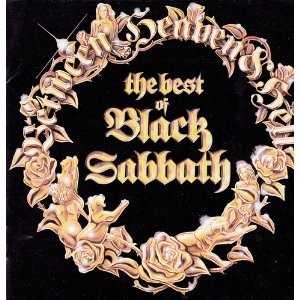 | Album: 30 of 42 Title: Between Heaven & Hell: The Best of Black Sabbath Released: 1993 Tracks: 16 Duration: 1:11:20 Scroll: Up Down Top Bottom 25% 50% 75% AlbumCover | 1 Black Sabbath (06:15) 2 Paranoid (02:48) 3 Iron Man (05:55) 4 Sweet Leaf (05:05) 5 Orchid (01:33) 6 Tomorrows Dream (03:08) 7 Laguna Sunrise (02:49) 8 Sabbath Bloody Sabbath (05:45) 9 Am I Going Insane (Radio) (04:16) 10 Never Say Die (03:49) 11 Hard Road (05:52) 12 Die Young (04:36) 13 Mob Rules (03:11) 14 Turn Up The Night (03:43) 15 Born Again (06:32) 16 The Shining (05:58) |
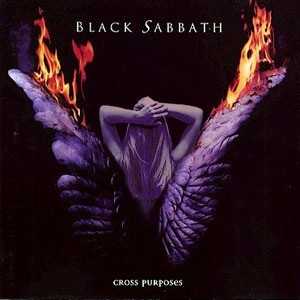 | Album: 31 of 42 Title: Cross Purposes Released: 1994-01-26 Tracks: 11 Duration: 50:38 Scroll: Up Down Top Bottom 25% 50% 75% Wikipedia Allmusic AlbumCover | 1 I Witness (04:58) 2 Cross of Thorns (04:34) 3 Psychophobia (03:14) 4 Virtual Death (05:49) 5 Immaculate Deception (04:15) 6 Dying for Love (05:53) 7 Back to Eden (03:57) 8 The Hand That Rocks the Cradle (04:30) 9 Cardinal Sin (04:21) 10 Evil Eye (05:59) 11 Whats the Use? (03:03) |
| Cross Purposes : Allmusic album Review : Cross Purposes could have been the ultimate Black Sabbath album. That may be a bold claim, but it combines members from several different eras together for perhaps the most promising lineup since Ronnie James Dios days with the band. Geezer Butler is there to represent the classic 70s version, Tony Martin returned to the fold to be the 80s representative, new drummer Bob Rondinelli brings the 90s flavor to everything, and Tony Iommi is the never-say-die (no pun intended) original member who never left the flock. But instead of crafting Sabbaths masterful return to grace, they made a weird mishmash of power metal and stoner rock that works more often than not. At least Butler seems to have Iommi attempting memorable riffs again, something he couldnt quite get the hang of until the album previous to this. "I Witness" opens with a classic guitar part, while the drums drive the song along and the bass chugs away with a newfound energy. But this energy is offset by the increasingly soulful vocals of Martin, who simply cannot muster the creepy wail that Ozzy Osbourne brought to the band. In fact, he puts in a performance that is even below the standards he set on albums like The Eternal Idol. The minute his voice starts on the first track, its as if Sabbath had to adjust to not make him sound out of place. Why the band couldnt have found a suitable replacement is a mystery, unless Iommi had simply given up on bringing in yet another singer after so many had come after Osbourne. "Virtual Death" is the brutally heavy shocker that suddenly appears in the middle of the album; it goes to show how they could have incorporated Martin much more effectively and is also the best slow crawl Iommi had worked on since 1983s "Zero the Hero." Butler does seem to have a good influence on Iommi whenever they work together, and their interplay becomes quite interesting as the album goes on. For whatever reason, most of the filler is at the beginning, leaving the better material to hang back for the second half. "Immaculate Deception" contains another good riff, although keyboardist Geoff Nichols spews inappropriate new age nonsense all over it. "Back to Eden" improves matters again with more wonderful interaction between Butler and Iommi, while "Cardinal Sin" is yet another good song that goes to show how misused Martin had been during his first run with the band. Many might disagree, but Cross Purposes is the first album since Born Again that actually sounds like a real Sabbath record. And it is probably the best thing theyd released since The Mob Rules, even with the filler tracks and keyboards. Of course, the lineup completely dissolved as Iommi perpetuated the bands downward spiral, but for a brief moment it seemed like Sabbath could have really shaped up into something special. | ||
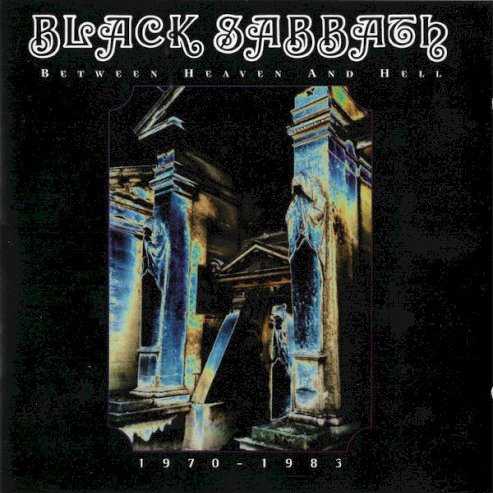 | Album: 32 of 42 Title: Between Heaven and Hell Released: 1995 Tracks: 15 Duration: 1:16:39 Scroll: Up Down Top Bottom 25% 50% 75% AlbumCover | 1 Hole in the Sky (04:00) 2 Into the Void (06:13) 3 Sabbath Bloody Sabbath (05:45) 4 N.I.B. (05:21) 5 Paranoid (02:48) 6 War Pigs / Luke’s Wall (07:56) 7 Iron Man (05:55) 8 Wicked World (04:44) 9 Supernaut (04:40) 10 Back Street Kids (03:48) 11 Never Say Die (03:49) 12 Neon Knights (03:48) 13 Mob Rules (03:11) 14 The Dark / Zero the Hero (08:16) 15 Black Sabbath (06:20) |
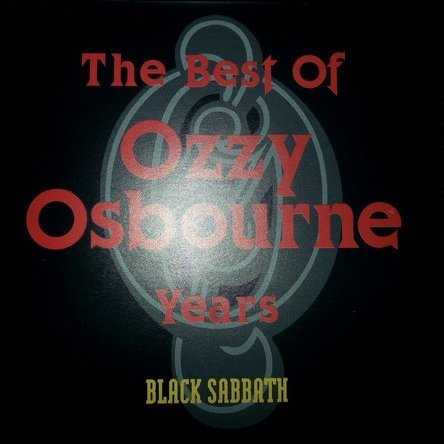 | Album: 33 of 42 Title: The Best of Ozzy Osbourne Years Released: 1995-02-22 Tracks: 27 Duration: 2:23:53 Scroll: Up Down Top Bottom 25% 50% 75% Allmusic AlbumCover | 1 Black Sabbath (06:17) 2 The Wizard (04:23) 3 Behind the Wall of Sleep (03:37) 4 N.I.B. (06:04) 5 Evil Woman (Don’t Play Your Games With Me) (03:24) 6 Warning (10:32) 7 War Pigs / Luke’s Wall (07:56) 8 Paranoid (02:48) 9 Iron Man (05:55) 10 Jack the Stripper / Fairies Wear Boots (06:14) 11 Electric Funeral (04:48) 12 Sweet Leaf (05:05) 13 Embryo (00:28) 14 Solitude (05:02) 1 Tomorrow’s Dream (03:10) 2 Changes (04:44) 3 Snowblind (05:29) 4 St. Vitus’ Dance (02:29) 5 Under the Sun (05:49) 6 Sabbath Bloody Sabbath (05:45) 7 A National Acrobat (06:13) 8 Sabbra Cadabra (05:57) 9 Killing Yourself to Live (05:41) 10 Who Are You? (04:10) 11 Am I Going Insane (Radio) (04:16) 12 Megalomania (09:42) 13 The Writ (07:45) |
 | Album: 34 of 42 Title: Forbidden Released: 1995-06-07 Tracks: 10 Duration: 44:15 Scroll: Up Down Top Bottom 25% 50% 75% Wikipedia Allmusic AlbumCover | 1 The Illusion of Power (04:54) 2 Get a Grip (03:59) 3 Cant Get Close Enough (04:28) 4 Shaking Off the Chains (04:04) 5 I Wont Cry for You (04:48) 6 Guilty as Hell (03:28) 7 Sick and Tired (03:31) 8 Rusty Angels (05:00) 9 Forbidden (03:49) 10 Kiss of Death (06:09) |
| Forbidden : Allmusic album Review : When the most influential heavy metal band ever to have roamed the earth teams up with Body Counts Ernie C to try and inject new life into their sound, it should have been the signal to give up the ghost. But poor Black Sabbath named an album Never Say Die because they meant it, and this sad album is a reminder of how dim even the brightest lights can get. Where their last album was an uneven but pleasant return to form, this is just the band going through the motions. "Get a Grip" takes its riff from Iommis own "Zero the Hero" and totally wrecks it; "Cant Get Close Enough" is an awful power metal ballad; and "Shaking Off the Chains" might be the worst Tony Martin-fronted Sabbath song. And that is a bold claim considering how awful Tyr was. "Illusion of Power" is the weirdest song, with Martin dueting with Ice T on a song that sounds much more like Body Count than anything Sabbath-related. "Sick and Tired" is the only standout track; with its bluesy tempo and decent vocals, it sounds like Helloween performing a Cream song. But considering the vast legacy behind the band, it is truly a sad state of affairs when their best material sounds like a mid-level power metal band. It is hard to pinpoint the worst Sabbath album, but this could be it. With boring songs, awful production (from Ernie C), and uninspired performances, this is easily avoidable for all but the most enthusiastic fan. As a side note, the reception to this album was so poor that Iommi cleared out the lineup, gave in, and finally reconciled with Ozzy Osbourne for their spectacular reunion tour. | ||
 | Album: 35 of 42 Title: Ozzy Osbourne: Best Tracks Released: 1996-02-21 Tracks: 14 Duration: 1:16:20 Scroll: Up Down Top Bottom 25% 50% 75% AlbumCover | 1 Paranoid (02:48) 2 War Pigs / Luke’s Wall (07:56) 3 Sabbath Bloody Sabbath (05:45) 4 Black Sabbath (06:17) 5 Iron Man (05:55) 6 The Wizard (04:23) 7 Warning (10:32) 8 Changes (04:43) 9 N.I.B. (06:04) 10 Am I Going Insane (Radio) (04:16) 11 Sweet Leaf (05:05) 12 Never Say Die (03:49) 13 Back Street Kids (03:49) 14 She’s Gone (04:53) |
 | Album: 36 of 42 Title: The Sabbath Stones Released: 1996-04-29 Tracks: 15 Duration: 1:17:25 Scroll: Up Down Top Bottom 25% 50% 75% Allmusic Wikipedia AlbumCover | 1 Headless Cross (06:32) 2 When Death Calls (06:55) 3 Devil and Daughter (04:44) 4 The Sabbath Stones (06:48) 5 The Battle of Tyr (01:08) 6 Odin’s Court (02:42) 7 Valhalla (04:42) 8 TV Crimes (04:02) 9 Virtual Death (05:49) 10 Evil Eye (05:59) 11 Kiss of Death (06:09) 12 Guilty as Hell (03:28) 13 Disturbing the Priest (05:49) 14 Heart Like a Wheel (06:37) 15 The Shining (05:55) |
| The Sabbath Stones : Allmusic album Review : Poor Black Sabbath had really fallen on hard times after the departure of Ronnie James Dio. He might have been the last truly respected singer in their history, and even his efforts couldnt win over the Ozzy Osbourne fans who had jumped ship and started following Osbournes solo career. So The Sabbath Stones tries to detail the period between Dios initial run with the group and their reunion with Osbourne in 1997. What this leaves for source material is one underrated but bland album with Ian Gillan and the original rhythm section, one mind-numbing disaster with Glenn Hughes on the mic, one reunion album with Dio, and four bizarre power metal experiments with singer Tony Martin. Most of the material is taken from Martins years with the group, and surprisingly enough there are some good songs featuring him. Although they are light years from "Hole in the Sky," guitarist/original member Tony Iommi managed to write some catchy anthems with Martin. "Headless Cross," "The Shining," and "Virtual Death" are standouts from their collaborations, running the gamut between stoner rock and power metal. Too much material is taken from Tyr, their weird Viking/Norse mythology concept album that fell flat for fans and critics alike. They also include a minute-long keyboard instrumental from the same album that needlessly takes up space between songs. The motivation is that IRS Records owned the rights to only a few of the albums, hence they over-emphasize the albums that they do own. But this does the band a great disservice, leading listeners to think their entire post-Dio period was made up of high-concept power metal. "TV Crimes," the lone track from the awkward Dio reunion of 1992, sounds like the same preachy Dungeons and Dragons rock he was making on his own, but with much better guitar playing. The material from Forbidden, their last album with Martin, is probably the worst of the bunch. These songs are confused, produced badly, and virtually unrecognizable when compared to the first 15 years of their career. As far as the pre-Martin material goes, the Ian Gillan-sung "Disturbing the Priest" is decent but they should have gotten "Zero the Hero" if they were to utilize that album. And "Heart Like a Wheel" from Iommis experimental Seventh Star is so incredibly bad, yet it might be the best choice from that album anyway. This is obviously a mixed bag, but strangely it works if only for the history lesson it provides. Fans of classic Sabbath should be given extreme caution -- this music is very different from anything they did with Ozzy Osbourne. Instead, this is the sound of an excellent band handling their fall from grace about as ungracefully as they could, and the entertainment value in that alone is worth the purchase. | ||
 | Album: 37 of 42 Title: Under Wheels of Confusion: 1970–87 Released: 1996-11-06 Tracks: 52 Duration: 4:27:39 Scroll: Up Down Top Bottom 25% 50% 75% AlbumCover | 1 Black Sabbath (06:20) 2 The Wizard (04:23) 3 N.I.B. (06:06) 4 Evil Woman (Don’t Play Your Games With Me) (03:24) 5 Wicked World (04:44) 6 War Pigs / Luke’s Wall (07:56) 7 Paranoid (02:48) 8 Iron Man (05:55) 9 Planet Caravan (04:34) 10 Hand of Doom (07:08) 11 Sweet Leaf (05:05) 12 After Forever (05:27) 13 Children of the Grave (05:17) 1 Into the Void (06:13) 2 Lord of This World (05:26) 3 Orchid (01:31) 4 Supernaut (04:40) 5 Tomorrow’s Dream (03:10) 6 Wheels of Confusion (08:14) 7 Changes (04:44) 8 Snowblind (05:29) 9 Laguna Sunrise (02:53) 10 Cornucopia (live) (04:03) 11 Sabbath Bloody Sabbath (05:45) 12 Killing Yourself to Live (05:41) 13 Hole in the Sky (04:00) 14 Am I Going Insane (Radio) (04:16) 1 The Writ (08:33) 2 Symptom of the Universe (06:32) 3 Dirty Women (07:10) 4 Back Street Kids (03:49) 5 Rock n Roll Doctor (03:26) 6 She’s Gone (04:53) 7 A Hard Road (06:06) 8 Never Say Die (03:49) 9 Neon Knights (03:53) 10 Heaven and Hell (06:57) 11 Die Young (04:45) 12 Lonely Is the Word (05:51) 1 Turn Up the Night (03:43) 2 Sign of the Southern Cross (07:52) 3 Falling Off the Edge of the World (05:06) 4 The Mob Rules (live) (03:21) 5 Voodoo (live) (05:30) 6 Digital Bitch (03:39) 7 Trashed (04:16) 8 Hot Line (04:52) 9 In for the Kill (03:42) 10 Seventh Sign (05:19) 11 Heart Like a Wheel (06:34) 12 The Shining (05:55) 13 Eternal Idol (06:34) |
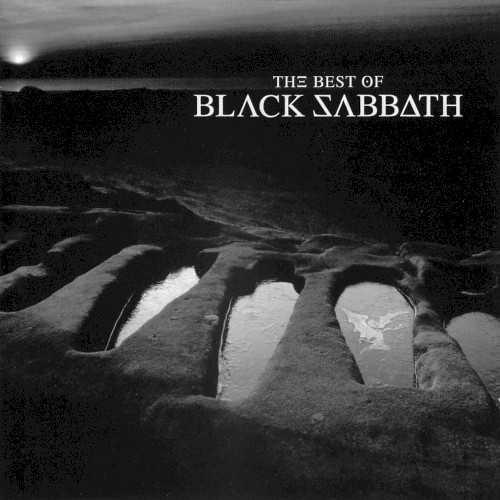 | Album: 38 of 42 Title: The Best of Black Sabbath Released: 1996-11-21 Tracks: 32 Duration: 2:38:45 Scroll: Up Down Top Bottom 25% 50% 75% Wikipedia AlbumCover | 1 Black Sabbath (06:20) 2 The Wizard (04:23) 3 N.I.B. (06:06) 4 Evil Woman (Don’t Play Your Games With Me) (03:24) 5 Wicked World (04:44) 6 War Pigs / Luke’s Wall (07:56) 7 Paranoid (02:48) 8 Planet Caravan (04:26) 9 Iron Man (05:55) 10 Electric Funeral (04:49) 11 Jack the Stripper / Fairies Wear Boots (06:14) 12 Sweet Leaf (05:05) 13 Embryo (00:28) 14 Children of the Grave (05:17) 15 Lord of This World (05:26) 16 Into the Void (06:13) 1 Tomorrow’s Dream (03:10) 2 Supernaut (04:40) 3 Snowblind (05:29) 4 Sabbath Bloody Sabbath (05:45) 5 Killing Yourself to Live (05:41) 6 Spiral Architect (05:30) 7 Hole in the Sky (04:00) 8 Don’t Start (Too Late) (00:49) 9 Symptom of the Universe (06:29) 10 Am I Going Insane (Radio) (04:16) 11 Dirty Women (07:08) 12 Never Say Die (03:49) 13 Hard Road (05:59) 14 Heaven and Hell (06:57) 15 Turn Up the Night (03:39) 16 The Dark / Zero the Hero (05:39) |
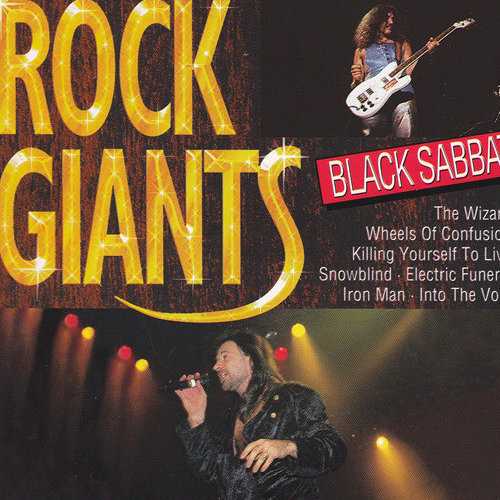 | Album: 39 of 42 Title: Rock Giants Released: 1997-08-20 Tracks: 14 Duration: 1:13:19 Scroll: Up Down Top Bottom 25% 50% 75% Allmusic AlbumCover | 1 Sabbath Bloody Sabbath (05:45) 2 The Wizard (04:23) 3 Sweet Leaf (05:05) 4 Electric Funeral (04:49) 5 Into the Void (06:13) 6 Wheels of Confusion (08:02) 7 Paranoid (02:48) 8 Iron Man (05:55) 9 Am I Going Insane (Radio) (04:16) 10 Killing Yourself to Live (05:41) 11 Snowblind (05:29) 12 Hole in the Sky (04:00) 13 Laguna Sunrise (02:53) 14 War Pigs / Luke’s Wall (07:56) |
| Rock Giants : Allmusic album Review : One of the most influential bands in heavy metal, Black Sabbath helped to define a genre with their dark lyricism and crushingly heavy riffs. Offering up an overview of the legendary bands powerful work, German compilation Rock Giants delivers 14 classic tracks. Featuring essential tracks like "Sweet Leaf," "War Pigs," and "Iron Man," the collection features tracks whose influence is buried deep in the DNA of most any metal band, and makes for a solid gateway into the shadowy world of heavy metals elder statesmen. | ||
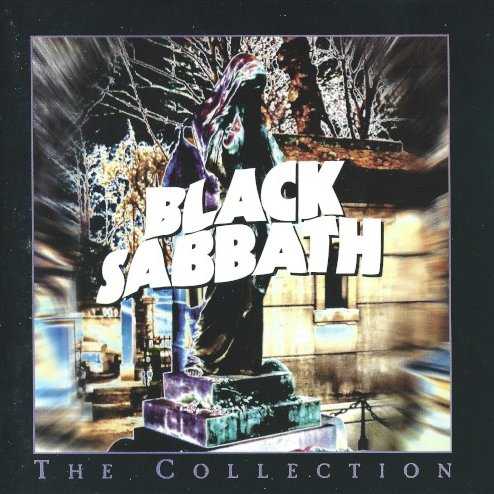 | Album: 40 of 42 Title: The Collection Released: 1999-06-28 Tracks: 15 Duration: 1:14:59 Scroll: Up Down Top Bottom 25% 50% 75% Spotify Allmusic AlbumCover | 1 Paranoid (02:48) 2 Tomorrow’s Dream (03:10) 3 Back Street Kids (03:49) 4 Symptom of the Universe (06:32) 5 Never Say Die (03:49) 6 Junior’s Eyes (06:42) 7 Dirty Women (07:10) 8 Am I Going Insane (Radio) (04:16) 9 Supernaut (04:40) 10 The Wizard (04:23) 11 A National Acrobat (06:13) 12 Electric Funeral (04:49) 13 Into the Void (06:13) 14 Spiral Architect (05:34) 15 Wicked World (04:44) |
 | Album: 41 of 42 Title: The Singles (1970–1978) Released: 2000-09-18 Tracks: 12 Duration: 53:06 Scroll: Up Down Top Bottom 25% 50% 75% AlbumCover | 1 Evil Woman (Don’t Play Your Games With Me) (03:24) 2 Wicked World (04:44) 1 Paranoid (02:48) 2 The Wizard (04:23) 1 Tomorrow’s Dream (03:10) 2 Laguna Sunrise (02:53) 1 Sabbath Bloody Sabbath (05:45) 2 Changes (04:44) 1 Never Say Die (03:49) 2 Shes Gone (04:50) 1 Hard Road (06:03) 2 Symptom of the Universe (06:29) |
 | Album: 42 of 42 Title: 13 Released: 2013-06-07 Tracks: 11 Duration: 1:08:48 Scroll: Up Down Top Bottom 25% 50% 75% Spotify Wikipedia Allmusic AlbumCover | 1 End of the Beginning (08:05) 2 God Is Dead? (08:52) 3 Loner (04:59) 4 Zeitgeist (04:37) 5 Age of Reason (07:01) 6 Live Forever (04:46) 7 Damaged Soul (07:51) 8 Dear Father (07:20) 1 Methademic (05:58) 2 Peace of Mind (03:40) 3 Pariah (05:34) |
| 13 : Allmusic album Review : Theres a lot of pressure involved with being the rulers of the underworld, and nobody knows it better than Black Sabbath in 2013. Inarguable legends and at least partially responsible for creating heavy metal as we know it with their classic 70s material, Sabbath have spawned generations of followers and become one of the final words of the genre. There have been countless reunions and mutations of the band following vocalist Ozzy Osbournes first dismissal in 1978, and even 13 doesnt quite deliver on fans decades-long desires to see all four original members back together. Original drummer Bill Ward sits the record out due to disputes over the recording contract, with Audioslave/Rage Against the Machine drummer Brad Wilk providing beats in his stead. Despite this considerable absence, 13 comes closest to recapturing the desperate feel, plodding grooves, and unparalleled metal magic of those first classic Sabbath records than anything the members of the band have done since, in any permutation or combination. Kicking off with two sludgy tracks, each over eight-minutes long, the Rick Rubin-produced 13 takes a few moments to get its legs. Once warmed up, however, each element falls somewhere between studied re-creation of the past and logical progression, be it Tony Iommis spooky guitar tone, Ozzys nasal howl, or the panic attack dynamics and sense of nuclear dread that made the moods of Sabotage and Vol. 4 so thick. Sharp tempo changes and caustic drop-tuned blues metal riffs make up tracks like "God Is Dead?" and the doomy "Age of Reason." Many of the albums eight tracks stretch past the seven-minute mark, full of heavy compositional shifting. The mellower acoustic track "Zeitgeist" rewrites the spacy "Planet Caravan" from second album Paranoid, revisiting the same cosmic motif of that song, complete with Iommis most Django Reinhardt-influenced soloing. The lyrics, all penned by bassist Geezer Butler, are focused on internal religious and mental conflicts, with final track "Dear Father" tackling living with memories of abuse. The album is heavier, more precise, and more interesting than the past several decades of output from the bandmembers would suggest. Without fully replicating the energy of their untouchable first six records, Sabbath have risen to the unique challenge of not becoming self-caricatures, turning in something new while still reactivating the strengths of their younger days. The backwards-looking tendencies of 13 are something the band is fully aware of, as signified by the reappearance of rain and church bells sound effects on the last track, the same sounds that opened their first album in 1970. The influence of early Sabbath has become so omnipresent that its come back to influence its very creators four decades later, but the results are unexpectedly brilliant, apocalyptic, and essential for any die-hard metal fan. | ||